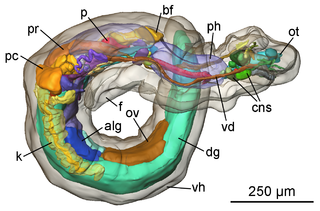
Linköping University is a public research university based in Linköping, Sweden. Originally established in 1969, it was granted full university status in 1975 and is one of Sweden's largest academic institutions.

Simultaneous localization and mapping (SLAM) is the computational problem of constructing or updating a map of an unknown environment while simultaneously keeping track of an agent's location within it. While this initially appears to be a chicken or the egg problem, there are several algorithms known to solve it in, at least approximately, tractable time for certain environments. Popular approximate solution methods include the particle filter, extended Kalman filter, covariance intersection, and GraphSLAM. SLAM algorithms are based on concepts in computational geometry and computer vision, and are used in robot navigation, robotic mapping and odometry for virtual reality or augmented reality.

OpenCV is a library of programming functions mainly for real-time computer vision. Originally developed by Intel, it was later supported by Willow Garage, then Itseez. The library is cross-platform and licensed as free and open-source software under Apache License 2. Starting in 2011, OpenCV features GPU acceleration for real-time operations.
libavcodec is a free and open-source library of codecs for encoding and decoding video and audio data.

Stanley is an autonomous car created by Stanford University's Stanford Racing Team in cooperation with the Volkswagen Electronics Research Laboratory (ERL). It won the 2005 DARPA Grand Challenge, earning the Stanford Racing Team a $2 million prize.
Neuroinformatics is the emergent field that combines informatics and neuroscience. Neuroinformatics is related with neuroscience data and information processing by artificial neural networks. There are three main directions where neuroinformatics has to be applied:

Sebastian Thrun is a German-American entrepreneur, educator, and computer scientist. He is CEO of Kitty Hawk Corporation, and chairman and co-founder of Udacity. Before that, he was a Google VP and Fellow, a Professor of Computer Science at Stanford University, and before that at Carnegie Mellon University. At Google, he founded Google X and Google's self-driving car team. He is also an adjunct professor at Stanford University and at Georgia Tech.

Stephen Malvern Omohundro is an American computer scientist whose areas of research include Hamiltonian physics, dynamical systems, programming languages, machine learning, machine vision, and the social implications of artificial intelligence. His current work uses rational economics to develop safe and beneficial intelligent technologies for better collaborative modeling, understanding, innovation, and decision making.
Mean shift is a non-parametric feature-space mathematical analysis technique for locating the maxima of a density function, a so-called mode-seeking algorithm. Application domains include cluster analysis in computer vision and image processing.

In computer vision and computer graphics, 3D reconstruction is the process of capturing the shape and appearance of real objects. This process can be accomplished either by active or passive methods. If the model is allowed to change its shape in time, this is referred to as non-rigid or spatio-temporal reconstruction.

A computer cluster is a set of computers that work together so that they can be viewed as a single system. Unlike grid computers, computer clusters have each node set to perform the same task, controlled and scheduled by software. The newest manifestation of cluster computing is cloud computing.
Computer stereo vision is the extraction of 3D information from digital images, such as those obtained by a CCD camera. By comparing information about a scene from two vantage points, 3D information can be extracted by examining the relative positions of objects in the two panels. This is similar to the biological process of stereopsis.
Error-driven learning is a type of reinforcement learning method. This method tweaks a model’s parameters based on the difference between the proposed and actual results. These models stand out as they depend on environmental feedback instead of explicit labels or categories. They are based on the idea that language acquisition involves the minimization of the prediction error (MPSE). By leveraging these prediction errors, the models consistently refine expectations and decrease computational complexity. Typically, these algorithms are operated by the GeneRec algorithm.
Gary Bradski is an American scientist, engineer, entrepreneur, and author. He co-founded Industrial Perception, a company that developed perception applications for industrial robotic application and has worked on the OpenCV Computer Vision library, as well as published a book on that library.
An AI accelerator, deep learning processor or neural processing unit (NPU) is a class of specialized hardware accelerator or computer system designed to accelerate artificial intelligence and machine learning applications, including artificial neural networks and computer vision. Typical applications include algorithms for robotics, Internet of Things, and other data-intensive or sensor-driven tasks. They are often manycore designs and generally focus on low-precision arithmetic, novel dataflow architectures or in-memory computing capability. As of 2024, a typical AI integrated circuit chip contains tens of billions of MOSFETs.
Reza Zadeh is an American computer scientist and technology executive working on machine learning. He is adjunct professor at Stanford University, CEO of Matroid, and a founding team member at Databricks. His work focuses on machine learning, distributed computing, and discrete applied mathematics. His awards include a KDD Best Paper Award and the Gene Golub Outstanding Thesis Award at Stanford.
David Stavens is an American entrepreneur and scientist. He was co-founder and CEO of Udacity; a co-creator of Stanley, the winning self-driving car of the DARPA Grand Challenge; and co-founder and CEO of Nines, a creator of AI-enabled FDA-approved medical devices. Stavens has published in the fields of robotics, machine learning, and artificial intelligence and has helped start organizations with an aggregate market value of over $30 billion.
Keno Fischer is a German computer scientist known for being a core member implementing the Julia programming language. He is an alumnus of Harvard for both his BA and MA. He works at Julia Computing, which he co-founded with Julia co-creators, Alan Edelman, Jeff Bezanson, Stefan Karpinski, Viral B. Shah and Deepak Vinchhi. He received a B.A. in mathematics and physics from Harvard in 2016, and he completed a Master of Arts in Physics also from Harvard in 2016.







